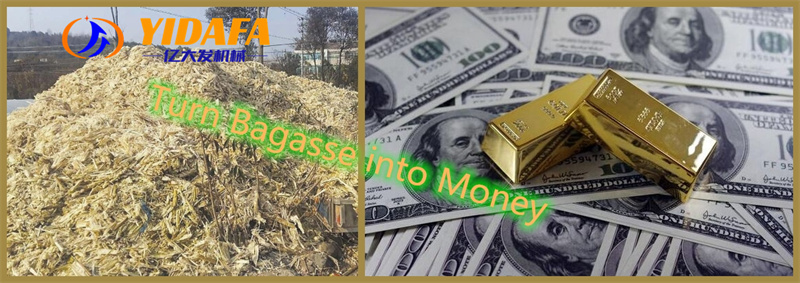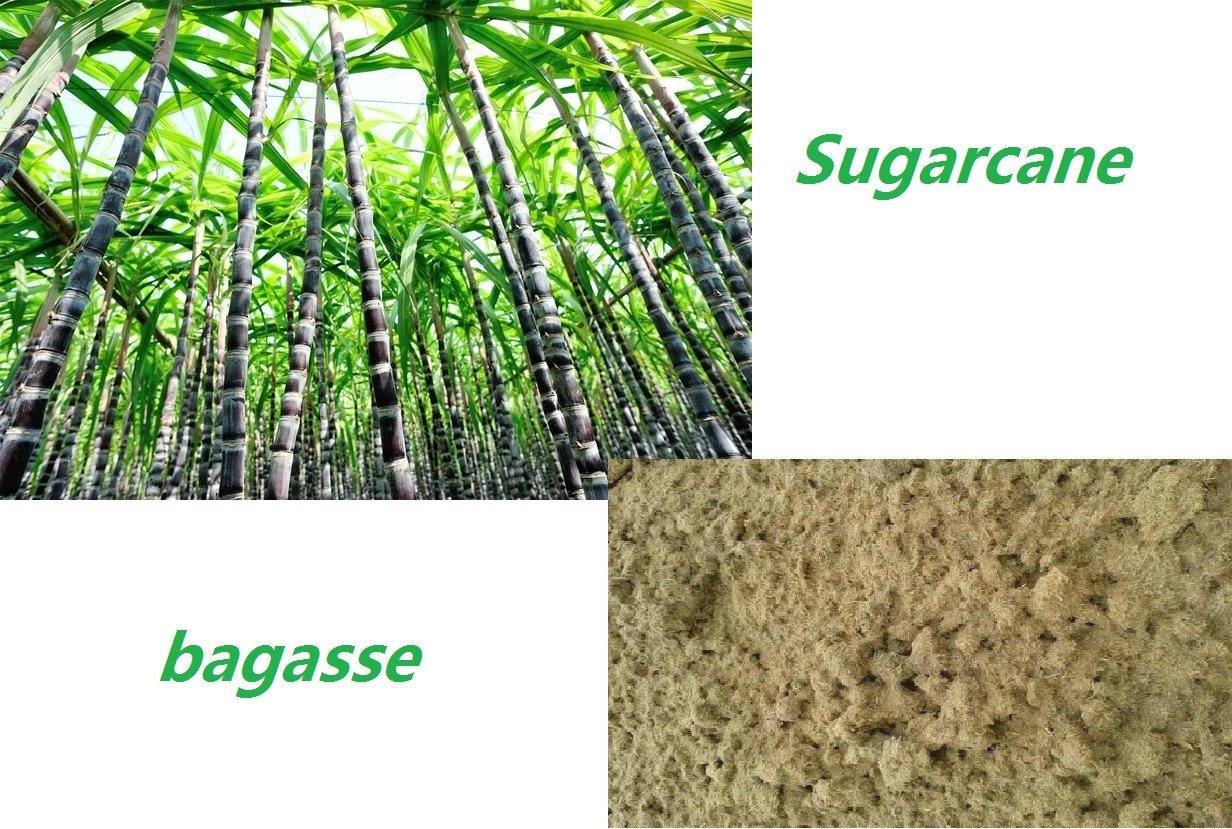THE "REAL TREASURE" GROWS OUT OF THE WASTE SUGARCANE BAGASSE
Sugar residue is a by-product of corn sugar industry, which is rich in nutrients, but this resource has not been reasonably and effectively utilized in China. Most enterprises sell sugar residue as feed with low added value directly to the feed industry. The economic benefits are very low and the sugar residue is not used reasonably and effectively.
According to incomplete statistics, the world's rice consumers are about 3.7 billion, while the sugar consumers are almost the entire population of the world, about 7.6 billion.
Sugarcane is the most important crop in the world. How about the cultivation of sugarcane in Myanmar? Myanmar is located in a tropical and temperate climate, so sugarcane can be planted nationwide except for a few areas. It is understood that Myanmar's sugarcane planting area is about 400000 acres, with a total output of about 8.4 million tons.

Bagasse is not used effectively
At present, the sugar factories in Myanmar are mainly distributed in Yangon, Mandalay, Sagong, Shan State, Bogu, Magui and other places, with a total of 23, squeezing more than 3 million tons of sugar cane and producing 300000 tons of white sugar.
After sugar cane is squeezed, bagasse, a by-product, will also be produced, which is mainly burned or discarded as fuel for sugar mills. The economic value of this method of utilization is very low.
At present, there is only one sugar factory in Myanmar, named Silver Liquid Pearl, which uses the bagasse produced to generate electricity.
In fact, bagasse still has huge application space. Once it is processed on a large scale, it can still produce good economic benefits.
1、 Degradable packaging materials
Degradation, plastic film, packaging In the production workshop of bagasse degradable environmental protection material products , the original waste bagasse was degraded and then made into degradable environmental protection new tableware.
"Usually this bagasse can only be used as toilet paper. Now it can be made into degradable tableware, and the economic benefits can be doubled." By using the high-quality bagasse of guests, the workshop can now produce 45000 tons of bagasse degradable environment-friendly material products annually.

It is understood that guests are important sugarcane planting areas in Guangxi. In recent years, Laibin City has continuously improved the comprehensive utilization level of sugar production, actively built the whole industrial chain, and extended the single sugar production into a comprehensive circular economy development pattern of sugar, pulp and paper, degradable environmental protection tableware, cogeneration and other aspects.
"At present, Laibin is exploring new ways to develop the comprehensive utilization of diversity in sugar production, promoting the extension and expansion of the whole sugar-related and sugar-related industrial chain to new application fields such as food, paper making, environmental protection tableware materials, pharmaceuticals, biodegradable materials, bioengineering, and striving to build the largest production base of degradable environmental protection materials in China." The relevant head of Laibin Municipal Bureau of Industry and Information Technology introduced.
According to statistics, at present, there are 7 degradable material production enterprises in Laibin, and the production capacity will reach 515,000 tons after all of them are put into production. The main products are degradable tableware, which are exported to European and American countries.
2、 Protein feed
In addition to making packaging materials, sugar residue can also be fermented into protein feed, and detailed operation steps can be made to improve the utilization rate.
Fermentation raw materials
Sugar residue, soybean meal, straw powder, salt, probiotics stock solution, well water.
The main purpose of soybean meal is to increase the content of feed protein, and then adjust the water content with straw powder. Of course, there may be differences in raw materials in different regions, so the corresponding ingredients can be replaced according to the local actual situation.
Method of fermenting sugar residue into protein feed
Fermentation ratio: sugar residue 800kg, straw powder 100kg, soybean meal 80kg, salt 3kg, probiotics raw liquid 2kg, nutrient 2kg, well water several.
Activate the stock solution: dissolve 2 kg of nutrient solution with 6 kg of warm water, add 10 kg of well water after dissolution and mix well, add and mix 2 kg of Rujin probiotics stock solution, seal and store for 48~72 hours, and wait for use.
Mix the materials and adjust the water content: mix the activation solution with other raw materials evenly, and adjust the water content to about 60% with straw powder (it is better to knead it into a ball without dripping, and disperse it at a touch). If there is a mixer, slowly add the activation solution into the sugar residue and stir it evenly; The farmers without mixer will slowly spray a small amount of activating liquid onto the feed and mix it evenly with a shovel.
Note: There should be no lumps and water lumps. Rub the lumps and water lumps by hand and mix evenly.
Sealing device: for large quantities, the prepared sugar residue can be compacted on the ground and piled into piles or put into cement tank for compaction, and sealed with plastic film; Small amount of sugar residue can be put into a cylinder, a large plastic bucket, and a pool to be compacted and sealed, and sealed with plastic film, with several layers to ensure that the seal is completely airtight. Remember to seal it, otherwise it will lead to feed fermentation failure or mildew.
Judging the quality of fermented protein feed from sugar residue: put it in a place with normal temperature and rat resistance for anaerobic fermentation, and ferment it for 5-7 days (3 days in summer, 5 days in spring and autumn, and 7 days in winter) according to the season, giving out a slightly sour and sweet strong flavor of koji, indicating that the fermentation is successful. If it is sour but not fragrant, there is no flavor of koji; Or it turns white, which is the reason why the fermentation is not successful due to incomplete sealing and ventilation. The sugar residue that fails to ferment can be dried and fermented again. The fermented sugar residue shall be compacted and sealed without air leakage; The water content is appropriate, more acid, less fermentation is too slow; Stir evenly and smash the lumps.
Drying and selling: After the fermentation is successful, it can be sold as protein feed. Before selling, the fermented sugar residue must be dried before selling. If it is not dried in the sun, it should be used up within one week, otherwise it is easy to deteriorate
3、 The application demand of bagasse pulp is increasing under the background of environmental protection
Bagasse pulp refers to the pulp produced from bagasse. As a by-product of sugar industry, bagasse pulp has the advantage of low cost and can be used to produce household paper. In recent years, affected by the upgrading of paper and the rising cost of raw materials, the proportion of non-wood pulp applications in China has been declining, but the domestic wood pulp production capacity is low, and the market demand depends on imports. As an important component of non-wood pulp, bagasse pulp plays an important role in improving the structure of domestic paper making, and the industry has a good development prospect.
According to the "2021-2025 Global Bagasse Pulp Industry Deep Market Research and Key Regional Research Report" released by the New Scientology Industry Research Center, Guangxi is the largest sugar cane production area in China, with sugar cane production accounting for about 62% of the total national output. In order to adhere to cleaner production, accelerate the elimination of backward production capacity, and take the development path of green paper making, the Guangxi government supports the development of bagasse pulp industry. The output of bagasse pulp in Guangxi is relatively stable, and the current annual output is about 720000 tons. At present, bagasse pulp has become an important link in Guangxi sugar industry chain. At present, bagasse pulp accounts for only 16% of the papermaking structure in Guangxi, and there is still room for improvement in the future.
Due to the relatively stable production of sugarcane and the relatively mature development of China's sugar industry, the production of bagasse pulp has been relatively stable in recent years, basically maintaining around 930000 tons. Although the domestic sugar cane production is still growing slowly, due to the good development of biomass power generation industry in recent years, many sugar enterprises are located in this field, and sugar residue is no longer sold. Bagasse is rarely found in the circulation market, resulting in a shortage of raw materials for paper enterprises, and the development of bagasse pulp industry is hindered. In addition, although the market concentration of sugar industry is relatively high at present, the bagasse output of the leading enterprises cannot meet the entry standard of pulp and paper industry, so the domestic sugar-paper integration project cannot be reached, which makes the cost of bagasse pulp and paper higher.
As a kind of small pulp, bagasse pulp is relatively small in scale, and affected by the factors of biomass power generation and production costs, the prosperity of bagasse pulp industry is low. With the full implementation of the plastic restriction order, packaging paper, paper towels, tableware and other products made from natural fiber are favored by consumers, so the bagasse pulp industry has a good development prospect.
Industry analysts in the new thinking circle said that bagasse pulp is a small number of pulp. As a supplement to the modern paper industry structure, it meets the diversification of paper making and alleviates the demand for wood pulp. In recent years, the demand has increased steadily. However, due to the high prosperity of the biomass power generation industry, China's sugar manufacturing enterprises have arranged in succession, the circulation of bagasse pulp in the market has decreased, and the development of sugarcane planting, sugar processing, paper making and other industries will be affected by the epidemic in 2020. The bagasse pulp industry is currently in a poor prosperity, but under the general trend of environmental protection, the industry has a good development prospect.